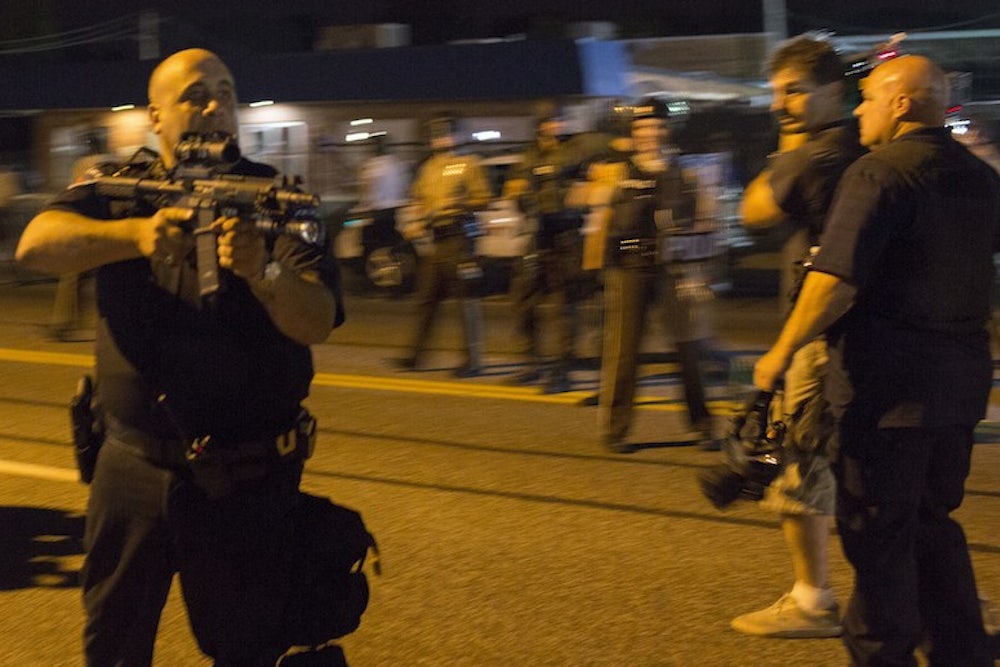You can probably relate to this. On a walk to the store or to grab lunch or just to clear your mind, you happen upon a disoriented, possibly intoxicated stranger, at turns muttering to himself and spitting unintelligible invective at you. It’s uncomfortable. It’s sad. It’s nerve-racking. You pick up your pace. A block later you’ve all but forgotten.
This happens every day in cities across the country. It is—or at least it seems—particularly common where poverty is concentrated and the poor lack access to mental health services. Something like this happened two days ago in St. Louis, Missouri—about four miles from Ferguson—to at least four different pedestrians, who happened to walk past 25-year-old Kajieme Powell moments after he allegedly shoplifted some donuts and energy drinks from a convenience store. The difference between their encounter and yours is that twenty seconds later Powell was dead. (Warning: The following video is disturbing.)
If you watch the video, there’s no denying that the introduction of police was a catalyst that rapidly turned a sad and touchy situation into a violent tragedy.
There’s also no denying that the store owner had every right to call the police.
And worst of all, there’s no denying that everything the St. Louis police did in the aftermath suggests they sincerely believe this was a justified, by-the-book killing. A witness filmed the encounter, but the police themselves released it to the public.
Judging by the public’s horrified reaction, Powell’s killing is a late awakening for a lot of people. Presumably that has something to do with the proliferation of camera phones, which went from virtually non-existent to omnipresent in the United States over the course of the last decade. But though precise protocols for police use of force vary from department to department, you probably won’t find many police who’ll say that what the police did to Kajieme Powell is a great or unjustifiable departure. And if that’s a shock to you, then you’re a newcomer to a very basic argument: That if this is proper protocol, then the protocol is bad.
Powell had a knife—Police Chief Sam Dotson described it as a steak knife. But he was not wielding it in the way officers claimed (or in the way it may have felt to them in the moment). He was not two or three feet away, but perhaps eight or nine. He wasn’t charging hard or issuing threats. To the contrary, he was demanding to be shot.
But that doesn’t mean the police needed to oblige him. It's hard to watch the video and not conclude that there should’ve been some safe way to preserve his life.
Police sympathizers will dismiss that suggestion as fantastical. The only cops who immobilize criminals by shooting them in the legs are movie cops. Tasers are a more realistic alternative, but would leave cops defenseless against a knife-wielding thug a few feet away if they missed (though you can apply that same argument to sidearms).
I claim no expertise, but I feel comfortable saying there’s an alternate scenario in which the police use a different but equally or more effective protocol and Powell survives. I also feel comfortable saying that the yawning disconnect between the official perception that the video is exculpatory, and the public reaction to it speaks to the protocol’s lack of legitimacy.
In a violent society, police will always end up killing people. But they have guns in Iceland. They have steak knives in Iceland. And yet last year, after police there killed a man who was shooting at them in Reykjavik, “the nation was in shock,” according to the news editor of the Icelandic National Broadcasting Service. “This does not happen in our country.” It was the first officer-involved killing in the country’s modern history.
We may never get close to Iceland's statistics, but there's no reason we shouldn't try.
This post has been updated.
